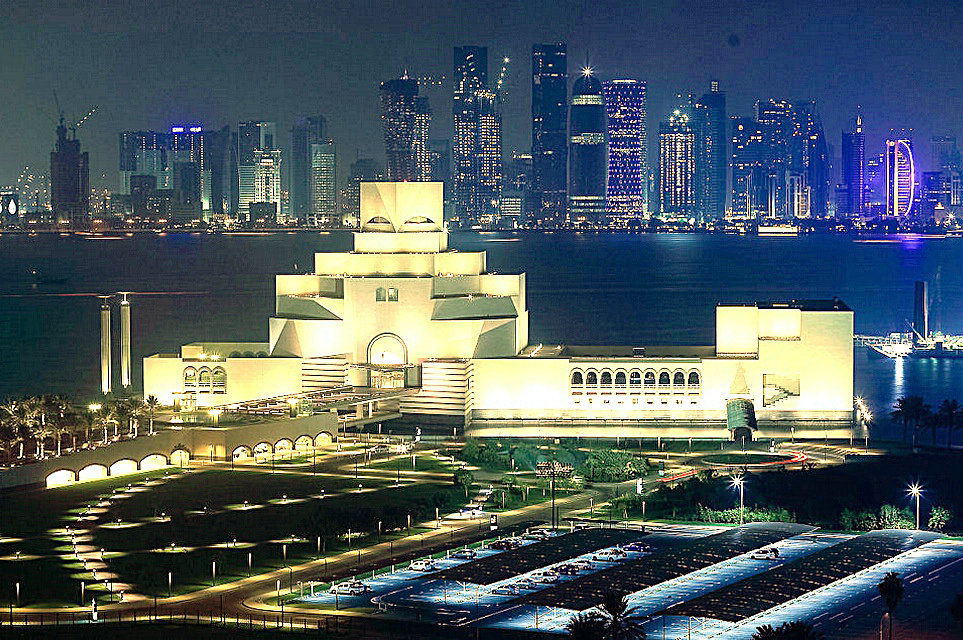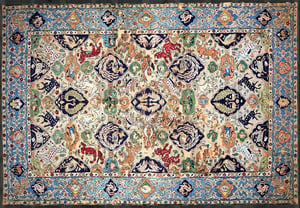The Museum of Islamic Art (Arabic: متحف الفن الإسلامي,) is a museum located on one end of the seven kilometers long Corniche in the Qatari capital, Doha. As with the architect I. M. Pei’s requirement, the museum is built on an island off an artificial projecting peninsula near the traditional dhow (wooden Qatari boat) harbor. A purpose-built park surrounds the edifice on the Eastern and Southern facades while 2 bridges connect the Southern front facade of the property with the main peninsula that holds the park. The Western and Northern facades are marked by the harbor showcasing the Qatari seafaring past.
The Museum of Islamic Art (MIA) represents Islamic art from three continents over 1,400 years. Its collection includes metal work, ceramics, jewelry, wood work, textiles and glass obtained from three continents and dating from the 7th to the 19th century.
The Museum of Islamic Art represents Islamic art from three continents over 1,400 years. MIA is the flagship of Qatar Museums which, under the leadership of its Chairperson H.E. Sheikha Al Mayassa bint Hamad bin Khalifa Al Thani, is transforming the State of Qatar into a cultural capital of the Middle East.
Set in the MIA Park on the waterfront, the museum building stands out as an architectural gem. Once inside, you will see masterpieces of Islamic art, including metalwork, ceramics, jewellery, woodwork, textiles and glass, collected from three continents and dating from the 7th to the 19th century.
The museum is influenced by ancient Islamic architecture, yet has a uniquely modern design involving geometric patterns. It is the first of its kind to feature over 14 centuries of Islamic art in the Arab States of the Persian Gulf.
Occupying a total area of 45,000 m2, the museum is located on an artificial peninsula overlooking the south end of Doha Bay. Construction of the building was done by a Turkish company, Baytur Construction in 2006. The interior gallery spaces were designed by a team of Wilmotte Associates. The museum was officially opened on November 22, 2008 by the then emir of Qatar, Sheikh Hamad. It opened to the general public on December 8, 2008.
At 91 years of age, the museum’s architect, I. M. Pei had to be coaxed out of retirement to undertake this enterprise. He traveled throughout the Muslim world on a six-month quest to learn about Muslim architecture and history and read Muslim texts to draw inspiration for his design. Declining all proposed sites for the museum, he suggested a stand-alone island for the structure in order to avoid encroachments by other buildings in the future. It was built off an artificial peninsula, approximately 60m off the Doha Corniche and surrounded by a some-what crescent shaped 290,000 m2 park. Pei requested that the museum spaces be designed by his collaborator on the Louvre project, Wilmotte & Associates, who then assembled a design team including Plowden & Smith (conservation consultants), Isometrix Lighting + Design (lighting consultants), SG Conseil (AV Consultants) under Turner Projacs. Along with this design team, Leslie E. Robertson Associates was the structural engineer for the project.
MIA sheds light on our origins to illuminate our future. Through safeguarding masterpiece collections of Islamic art and showcasing extraordinary exhibitions, MIA shares knowledge, spreading curiosity, understanding, and joy.
Our vision is that MIA is recognised as the centre of knowledge, dialogue and inspiration that illuminates the art of Islamic civilisations, opening minds and shaping the future.
Collections:
The museum houses a collection of work gathered since the late 1980’s including manuscripts, textiles and ceramics. It is one of the world’s most complete collections of Islamic artifacts, with items originating in Spain, Egypt, Iran, Iraq, Turkey, India, and Central Asia.
Facilities inside the 5-storied museum include temporary and permanent galleries, a gift shop, a library, a cafe, a 200-seat theater, classrooms and a restaurant. There are prayer rooms and ablution facilities inside to cater to Muslim visitors.
External facilities that form part of the crescent shaped MIA park include walking tracks, cycling tracks, a carousel, cafes, rest rooms and boat rentals.
Cermics
As well as being objects of great age and beauty, the ceramics in the museum were also meant to be used.
From humble kitchen wares to elaborate tile panels, ceramics were a vital part of everyday life in the Islamic world.
They exemplify the external influences and internal creativity that inspired this flourishing of ceramic design over 12 centuries.
Galss
The MIA collection includes some of the most famous pieces of Islamic glass, ranging from delicate early pieces to brightly coloured mosque lamps, goblets and vases of the mediaeval period.
As a medium which could be employed for decorative as well as functional purposes, old glass can help shed new light on how people lived in the past.
Metalwork
Much of the metalwork collection is fit for caliphs, emperors and sultans. Highly skilled metalworkers crafted vessels of bronze, brass or steel, which they decorated with gold and silver.
From arms and armour and scientific instruments, to household objects, the collection represents the highest-quality metal work of the Islamic world from the 7th century to modern times.
Manuscripts
The collection has over 800 manuscripts from Qur’ans from the 7th century to Ottoman works of the 19th century. As well as the Qu’rans, you will see manuscripts on science, literature and religious subjects.
The famous Abbasid Blue Qur’an is one the finest and rarest manuscripts in the Islamic world.
The museum displays two of only five known pages from the largest Qur’an in the world, the Timurid Baysunghur Qur’an.
Textile
The MIA textile collection has some of the finest examples of carpets, costumes and a wide variety of fabrics produced for the elite of the Islamic world.
Although only a small number of textiles have survived, especially from before the 16th century, such items were some of the most important luxury products of the Middle East.
Ceramil Bowl
This bowl was made in Basra, in today’s Iraq, a leading centre of fine pottery during the time of the Abbasid Caliphate (750-1258 CE). The Abbasid caliphs ruled much of North Africa, the Middle East and Greater Persia from their capital city Baghdad. Elegant Kufic scripts, like the lettering that decorates this bowl, were the earliest modes of Arabic calligraphy and used throughout Abbasid territories. The inscription on the bowl reads ‘what was done is worthwhile’.
Education:
We offer a range of activities, information and resources to help you learn more about our collection, special exhibitions and Islamic Art.
Our education team and guides build enriching and fun learning experiences for visitors. Our curators and conservators provide insights into our collections and their care. Visiting academics and experts give frequent lectures and seminars.
MIA is part of Qatar Museums Authority. Admission to the museum and park are free. The park is open 24 hours to cater to residents of the city.










